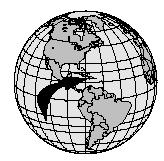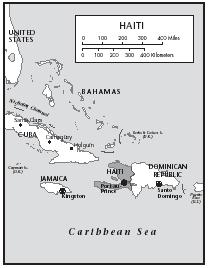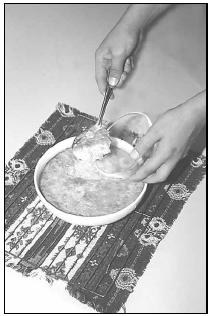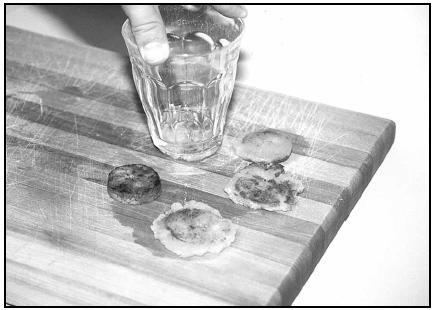Haiti
Recipes

1 GEOGRAPHIC SETTING AND ENVIRONMENT
Haiti occupies the western third of the island of Hispaniola (the Dominican Republic occupies the eastern two thirds). Haiti is slightly larger than the state of Maryland, with an area of 27,750 square kilometers (10,714 square miles) including several islands. Three main mountain ranges, separated by open plains, stretch across the country. The climate is tropical, with some variation depending on altitude. Coffee, cocoa, coconuts, avocado, orange, lime, and mango grow wild. The most important commercial crops are coffee and sugarcane. Other important crops include bananas, corn, rice, sorghum, beans, and cocoa beans. The virgin forests that once covered the entire country have now been reduced to about 4 percent of the total land area.
2 HISTORY AND FOOD
Spain, France, the continent of Africa, and later the United States, were crucial in shaping traditional Haitian cuisine. Throughout its history, several foreign countries gained control of Haiti, introducing food and ideas from their native lands, many of which significantly affected the foods modern Haitians eat.
The island of Hispaniola, which encompasses both Haiti and the Dominican Republic, was inhabited by hunter-gatherers as early as 5000 B.C. Fruits and vegetables such as guavas, pineapples, cassava, papayas, sweet potatoes, and corn were cultivated by early Haitian tribes, particularly the Arawak and Taino Indians. It was not long before the first European arrived on the island and began introducing oranges, limes, mangoes, rice, and sugarcane. Slaves from Africa were eventually transported to Haiti to work the sugarcane plantations.

On December 6, 1492, Christopher Columbus landed on the island and named it La Isla Espanola (later named Hispaniola), or the Spanish Island, and claimed it for Spain. The Spaniards called it Santo Domingo. The Spanish established sugar plantations and made the native Indians work as slaves. Hard labor and disease nearly wiped out the indigenous population by 1520, forcing the Spaniards to ship slaves from Africa to work the plantations instead. The Africans introduced okra (also called gumbo; edible pods), ackee (red and yellow fruit), taro (edible root), pigeon peas (seeds of an African shrub), and various spices to the diet. They later introduced such Haitian specialties as red beans and rice and mirliton (or chayote ; a pear-shaped vegetable) to Louisiana's Creole cuisine.
By 1700, the French had taken control of Hispaniola from Spain. The French colonists successfully cultivated sugarcane, coffee, cotton, and cocoa with the help of African slaves.
Haitians won their independence and became the first African-American republic in the New World in 1804. French rule, however, remains evident in modern Haitian society, particularly in the wide use of the French language, and in the contributions to the country's cuisine. French cheeses, desserts, and breads are commonly found at local markets and stores.
French-Style Lettuce Salad
Ingredients
- 1 head lettuce
- 1 garlic clove, sliced
- 2 Tablespoons salad oil
- 1 Tablespoon wine vinegar
- ¼ teaspoon salt
- Pepper, to taste
- 1 Tablespoon parsley, minced
- 1 teaspoon lime juice
Procedure
- Wash, drain, and thoroughly dry the lettuce.
- Rub a salad bowl with garlic and add the other ingredients to the bowl.
- Mix well.
- Tear lettuce leaves into bowl.
- Just before serving, toss thoroughly.
Serves 4 to 6.
Corn Pudding
Ingredients
- 1 Tablespoon cornstarch
- 1 Tablespoon flour
- 1 Tablespoon sugar
- 1 can creamed corn
- Salt
- 2 eggs, beaten
- ½ cup milk
- 1 teaspoon vanilla
- 3 Tablespoons butter, melted
Procedure
- Preheat oven to 325°F.
- Combine cornstarch, flour, sugar, and salt in a saucepan.
- Stir in creamed corn and beaten eggs.
- Add the milk, vanilla and butter.
- Mix well and pour into a shallow casserole dish and bake for about 1 hour.
Serves 2 to 4.
Spiced Cocoa
Ingredients
- 3 egg whites
- ¾ cup cocoa
- 1 teaspoon cinnamon
- 4 to 8 Tablespoons sugar, to taste
- 1 cup cold milk
- 11 cups milk

Procedure
- Mix egg whites, cocoa, cinnamon, and sugar into a paste.
- Dilute the paste with 1 cup of cold milk.
- Boil the remaining 11 cups of milk over low heat.
- Gradually add the paste to the boiling milk, beating constantly.
- Serve hot and foamy.
Serves 12.
Mango Juice
Ingredients
- 4 cups water
- 3 cups orange juice
- 2 mangoes
- 1 cup sugar
Procedure
- Boil the sugar and water together until sugar is dissolved; let mixture cool.
- Scoop out the mango flesh and combine with orange juice in a blender.
- Add the sugar water with puree and continue to blend.
- Pour into a pitcher filled with ice cubes and serve.
Serves 8.
3 FOODS OF THE HAITIANS
Haitian food is often lumped together with other Caribbean islands as "Caribbean cuisine." However, Haiti maintains an independently unique flavor. Unlike its Spanish-influenced counterpart, the Dominican Republic, Haitian cuisine is based on Creole and French cooking styles. Strong pepper flavoring in many dishes also sets Haitian food apart from the other islands.
Several dishes are specifically native to Haiti, including rice djon-djon (jon-JON). It requires Haitian black mushrooms, locally grown fungi. The stems of the mushrooms are used to color the rice black, then the mushroom caps with lima beans are used as a tasty topping. Calalou (kah-lah-LOO), consisting of crabmeat, salted pork, spinach, onion, okra, and peppers, and pain patate (pane pah-TAT), a sweetened potato, fig, and banana pudding, are other native dishes to Haiti. Soup jomou (pumpkin soup) is traditionally served for lunch on Sundays.
In general, the average Haitian diet is largely based on starch staples such as rice (which is locally grown), corn, millet, yams, and beans. However, wealthier residents can afford meats (usually pork and goat), lobster, spiced shrimp, duck, and sweet desserts such as French-influenced mousse and pastries.
Extravagant fare such as frog legs, cold cuts, and French cheeses are available (typically in Port-au-Prince, Haiti's capital), but they are not commonly eaten by the average Haitian. Riz et Pois , the country's national dish of rice and beans, is more common fare. It is relatively inexpensive, and the rice and beans provide carbohydrates for field workers. Mayi moulen (cornmeal mush) cooked with kidney beans, coconut, and peppers, and pikliz (spicy pickled carrots and cabbage) can be filling, and its ingredients are usually affordable. Haitians also tend to frequently fry their meals in pig fat to give them greater flavor. Bannann peze (fried plantains, similar to bananas), poule (fried chicken), tasso (deep-fried beef), and grio (fried pork) are common examples.
Haiti's tropical Caribbean climate allows for tropical fruits such as avocados, mangoes, pineapples, coconuts, and guava to grow in abundance. Such fruits are often used to make refreshing fruit juices. Other popular beverages include shaved ice topped with a fruity syrup, Juna (a locally produced orange squash drink), and even sugarcane. Both adults and children enjoy chewing on the stalks to extract its sweet juice.

Bannann Peze (Fried Plantains)
Ingredients
- ½ cup vegetable oil
- 2 medium-sized green plantains, peeled and sliced
Procedure
- In a heavy 12-inch skillet, heat the oil over moderate heat.
- Add as many plantain slices as you can without crowding the pan and brown for about 2 minutes on each side.
- As they brown, transfer them to paper towels to drain.
- On a board, using a spatula, press each slice flat and round, about ¼-inch thick and 2 inches in diameter.
- Heat the oil and fry the rounds again for about 1 minute on each side.
- Drain on paper towels and serve immediately.
- Serves 4.
Riz et Pois Rouges (Rice and Red Beans)
Ingredients
- 1 medium onion, chopped
- 3 cloves garlic, minced
- 1 medium green bell pepper, chopped
- 2 Tablespoons vegetable oil
- 1 cup rice, uncooked
- 2 cans (15 ounces each) kidney beans, drained
- ¼ pound ham, chopped
- ½ teaspoon cumin
- ¼ teaspoon salt
- ¼ teaspoon oregano
- ¼ teaspoon crushed red pepper
- 2½ cups boiling water
Procedure
- Preheat oven to 350°F.
- Heat oil in a large skillet.
- Cook and stir the onion, garlic, and green pepper until tender, about 3 minutes.
- In a separate bowl, combine and mix all the remaining ingredients.
- Add the onion mixture to the bowl and stir well.
- Pour entire mixture into an ungreased 2-quart casserole dish.
- Cover and bake until liquid is absorbed and rice is tender, about 55 minutes.
- Stir before serving.
Makes 5 to 6 servings.
Riz Djon-Djon (Rice and Haitian Mushrooms)
Ingredients
- 2 cups long grain rice
- 1 cup Haitian black mushrooms (or dried, black European mushrooms)
- 2 cloves garlic, finely chopped
- 4 Tablespoons butter
- Salt, pepper, and thyme, to taste
Procedure
- Remove the stems from the mushrooms and soak them in a cup of hot water for 30 minutes.
- Soak the heads in a separate cup of hot water.
- Sauté the rice and garlic in butter, then add all the other ingredients, including the water used to soak the mushrooms (discard the mushroom stems, which are inedible).
- Cook for 20 minutes and serve.
Serves 6.
Haitian Fruit Salad
Ingredients
- 2 oranges, peeled and sectioned
- 3 bananas, sliced
- ½ cup melon balls
- ½ cup strawberries, sliced
- 4 slices pineapple, diced
- ½ cup raspberries
- ¼ cup roasted peanuts
- ¼ cup pineapple juice
- ¼ cup lime juice
- 1 cup sweetened condensed milk
- Shredded coconut (optional)
Procedure
- In a large bowl, combine oranges, bananas, melon balls, strawberries, pineapple, raspberries, and nuts.
- In a separate bowl, combine the pineapple juice, lime juice, condensed milk, and beaten eggs.
- Pour the juice mixture on top of the fruit.
- Top with shredded coconut.
Serves 4.
4 FOOD FOR RELIGIOUS AND HOLIDAY CELEBRATIONS
Religion is an important part of Haitian life and culture. The two main religions are Roman Catholicism and Voudou (or Voodoo), a mixture of African animism (belief in spirits and nature) and Christianity. In addition to visiting family and enjoying delicious meals together, religious and secular (nonreligious) celebrations are also a time to forget about everyday poverty and hardship.
Roman Catholics observe such holidays as Good Friday, Easter Sunday, and Christmas—one of the most celebrated of all Christian holidays worldwide. On Christmas Eve in Haiti, Roman Catholics attend midnight mass, followed by a celebration dinner and gift exchanges. Children will also travel through local streets carrying a small house or church that they have made ahead of time with strips of cardboard called a fanal (fah-NAHL). Typically, only the homes of the wealthy will own a Christmas tree, but everyone in a village might get to enjoy pis d'etoil (firecrackers).
Haitians who practice voudou enjoy harvest festivals that take place for two days each November. Haitian peasants observe Manger-Yam (mahn-djay YAM), literally meaning "eat yam" day. Along with singing and dancing, the festival is celebrated by feasting and drinking. The purpose of this day is to recognize the importance of the yam in the rural Haitian diet.
National holidays, holidays observed and celebrated by the majority of the population (regardless of religious beliefs), are also popular. November 2 is All Souls' Day (or the Day of the Dead). On this special day, loved ones who have passed away are honored and their lives celebrated through storytelling, eating, and drinking. Many people choose to place food in front of a loved one's grave or on the table where they used to eat. Only after the food has been offered will the rest of the family enjoy their own meals.
A Typical Christmas Menu
Fried pork or goat
Pikliz (spicy pickled carrots and cabbage)
Fried plantains
Pain Patate (sweetened potato, fig, and banana pudding)
Haitian bread
Pineapple Nog
Probably the most widely celebrated event in Haiti is known as Carnival, or Mardi Gras. Though the main attraction is music, these three days preceding Ash
Wednesday each February (known as "Fat Tuesday" in the United States) are also marked by days of celebratory feasting.
Pain Haïtien (Haitian Bread)
Ingredients
- 2 packages active dry yeast
- 1½ cups warm water
- ¼ cup honey
- 2 Tablespoons vegetable oil
- 1 teaspoon salt
- ¾ teaspoon ground nutmeg
- 4 cups flour
- ¼ teaspoon instant coffee
- 2 Tablespoons milk
Procedure
- Preheat oven to 350°F.
- Dissolve the yeast in a large bowl in warm water.
- Stir in honey, oil, salt, nutmeg, and 2 cups of the flour.
- Beat until very smooth, about 1 minute.
- Gradually add enough of the remaining flour to make a stiff dough.
- Turn dough onto a lightly floured surface; knead until smooth, about 5 minutes.
- Place in a greased bowl, cover, and let rise in a warm place until about double in size, about 50 minutes. Punch down on dough.
- Press in greased jelly roll plan (about 15x10x1-inch).
- Cut dough into about 2½-inch squares with a sharp knife, cutting two-thirds of the way through the dough.
- Cover and let rise until double in size, about 30 minutes.
- Dissolve the instant coffee in the milk and brush over the dough.
- Bake until the bread is golden brown, about 35 minutes.
- Break the bread into squares to serve.
Makes 2 dozen squares.
Pineapple Nog
Ingredients
- 1 can pineapple, crushed
- ⅛ teaspoon nutmeg, plus additional for topping
- ½ cup coconut milk
- 1 cup milk
Procedure
- Combine all the ingredients in a blender and mix well.
- Top the drink with additional nutmeg.
Serves 4 to 6.
5 MEALTIME CUSTOMS
Most of Haitian society consists of peasants who live a simple lifestyle. On a small plot of owned or rented land, the peasants usually cultivate beans, sweet potatoes, maize (similar to corn), bananas, or coffee (and sometimes a combination). Men plant and harvest the crops while the women typically take care of the children, prepare meals, and sell the extra crops they have grown (if there are any) at the local market.
Markets are frequently the center of economic and social activity in small Haitian villages, and a place where mostly women can be seen selling produce. Markets located in tourist areas, such as Port-au-Prince, the country's capital, often open for business as early as 5 A.M. It is normal for women to sometimes walk several miles each way to the market carrying large baskets of produce on their heads. Though vegetables and fruits are probably the most commonly sold food, salted codfish, and various meats, and manioc flour are also popular. There are no refrigerators, so seafood and meat is typically covered in salt to help preserve it in the warm, outdoor markets. Other homemade products such as clothing, cooking utensils, and baskets are also sold.
Ready-to-eat meals are also available, usually for the hungry tourist. The most popularly sold dish is a porridge made of a ground corn, sugar, and milk, cooked over a large fire. It is usually eaten immediately after it has been purchased, typically served in a tin cup.
Peasants themselves usually begin the day with a light breakfast of locally grown coffee and bread made of manioc flour (wheat flour is often too expensive for the typical Haitian peasant, who has very little money). Most peasants work in the fields and take a break for a light snack around midday. Another break from fieldwork (as well as a chance to see his family) is in the late afternoon when peasants often return home to eat the main meal of the day. Unfortunately, the main meal of the day may be little more than what was eaten for the midday snack—porridge and possibly a freshly grown fruit, such as pineapple, coconut, or mango. Haiti's national dish of beans and rice may also be eaten. Pumpkin soup is traditionally eaten for lunch on Sundays, for those who can afford its ingredients (it is also eaten on New Year's Day for good luck).
Spicy, flavorful sauces are common in several Haitian dishes, particularly to season bland peasant dishes. The most popular sauce is ti-malice (tih-mah-LISS), a very spicy tomato and onion mixture.
Ti-Malice (Spicy Haitian Sauce)
Ingredients
- 10 large tomatoes, peeled and quartered
- 3 white onions, quartered
- 4 red hot peppers (jalapeños work well), seeded
- 3 Tablespoons brown sugar
- 1 Tablespoon salt
- 2 cups malt vinegar
Procedure
- Purée the tomatoes, onions, and peppers in a food processor.
- Transfer to a large saucepan and add the brown sugar, salt, and malt vinegar.
- Stir well to combine.
- Cook the sauce over medium heat, stirring occasionally, until it begins to boil.
- Lower the heat and simmer for 20 minutes, continuing to stir occasionally.
- Serve with any Haitian rice or meat dish.
Cornmeal Porridge
Ingredients
- 6 cups water
- 1 teaspoon salt (optional)
- 2 cups cornmeal
- 2 Tablespoons butter, margarine, canola oil, or olive oil
Procedure
- Bring water to boil in a large pot. Add the salt, if desired.
- Gradually stir in cornmeal with a whisk. Turn heat down to medium.
- Stir briskly to get the lumps out, then cook for another 10 to 20 minutes, stirring frequently (add water if it becomes too thick).
- Remove from heat and stir in butter or oil.
- Serve immediately or pour into a square pan.
- Let cool and cut into squares.
Serves 4 to 6.
6 POLITICS, ECONOMICS, AND NUTRITION
About 61 percent of the population of Haiti is classified as undernourished by the World Bank. This means they do not receive adequate nutrition in their diet. Of children under the age of five, about 28 percent are underweight, and nearly one-third are stunted (short for their age).
Haiti is the poorest country in the Western Hemisphere, with unemployment rates as high as 70 percent of the population. Many families cannot afford healthy, vitamin-enriched meals, although mangoes are frequently eaten to avoid a Vitamin A deficiency. In addition, only about one-quarter of Haitians have access to adequate sanitation.
Although the country is surrounded by an abundance of water, it continues to lack water in both quantity and quality. Poor nutrition and sanitation have caused Haiti to have one of the youngest life expectancies. In 1998, the average life expectancy was 54.4 years of age.
7 FURTHER STUDY
Books
Cheong-Lum, Roseline. Haiti: Cultures of the World . Tarrytown, NY: Marshall Cavendish Corporation, 1995.
Web Sites
Baptist Haiti Mission. [Online] Available http://www.bhm.org (accessed April 16, 2001).
Culinary Specialties of Haiti. [Online] Available http://pasture.ecn.purdue.edu/~agenhtml/agenmc/haiti/food.html (accessed April 16, 2001).
Recipe Goldmine. [Online] Available http://www.recipesgoldmine.com/caribbean2.html (accessed April 16, 2001).
Merci beaucoup
Joaquin